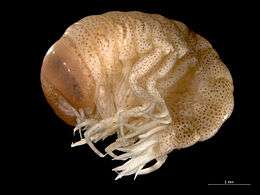Hyperiidea
The Hyperiidea are a suborder of amphipods, small aquatic crustaceans. Unlike the other suborders of Amphipoda, hyperiids are exclusively marine and do not occur in fresh water. Hyperiids are distinguished by their large eyes and planktonic habitat. Most species of hyperiids are parasites or predators of salps and jellyfish in the plankton, although Themisto gaudichaudii and a few relatives are free-swimming predators of copepods and other small planktonic animals.
| Hyperiidea | |
|---|---|
 | |
| Hyperia galba (Hyperiidae) | |
| Scientific classification | |
| Kingdom: | |
| Phylum: | |
| Subphylum: | |
| Class: | |
| Order: | |
| Suborder: | Hyperiidea H. Milne-Edwards, 1830 |
| Families | |
|
See text | |
Taxonomy
According to Vinogradov et al. in 1996,[1] 233 species of Hyperiidea are known.
Some controversy exists as to the number of families in the Hyperiidea, being given as between 20 and 23 depending on whether groups like the Thaumatopsidae are considered distinct or not. The taxonomy of Hyperiidea currently accepted by the World Register of Marine Species is as follows:[2]
|
|
Distribution
Hyperiidea are known from many oceans of the world, including 69 species in the Southern Ocean.[3]
References
- Vinogradov, M. E.; A. F. Volkov & T. N. Semenova (1996). Hyperiid amphipods (Amphipoda: Hyperiidea) of the world. Lebanon, N. H.: Science Publishers. ISBN 1-886106-48-7.
- "Hyperiidea". WoRMS. World Register of Marine Species. Retrieved 2 July 2020.
- C. De Broyer; K. Jazdzewski (1993). "Contribution to the marine biodiversity inventory: A checklist of the Amphipoda (Crustacea) of the Southern Ocean". Doc Trav Inst R Sci Nat Belg. 73.